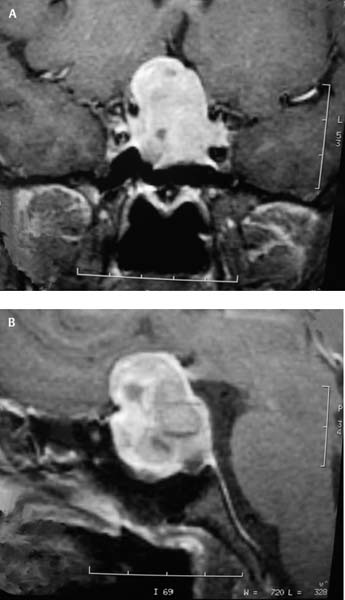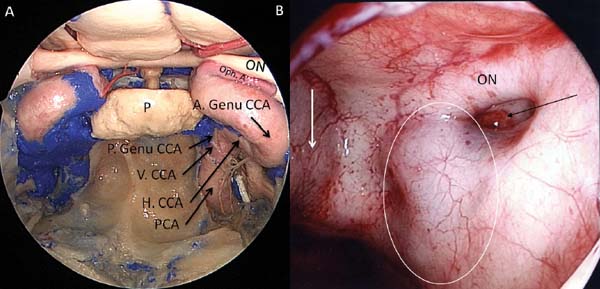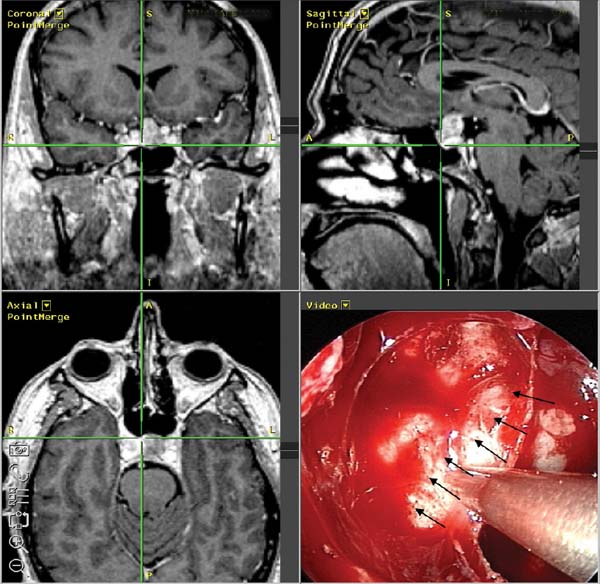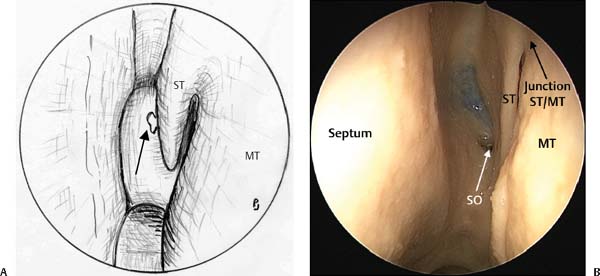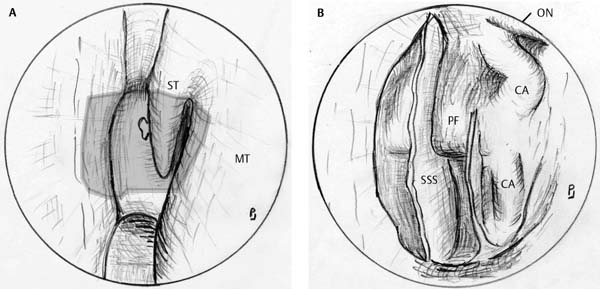13 Pituitary tumors are commonly benign pituitary adenomas and only rarely are pituitary carcinomas or posterior pituitary neoplasias diagnosed.1 Pituitary adenomas present most commonly in the third and fourth decades.1 Their clinical presentation depends whether the tumor is secreting (less common) or nonsecreting (more common).1 Secreting adenomas present with the endocrine manifestations of the hormone secreted.1,2 The most common is a prolactin- secreting tumor, followed by growth hormone, adrenocorticotropic (ACTH), follicle-stimulating hormone, and luteinizing hormone.1,2 Nonsecreting adenomas usually present due to their mass effects. Symptoms may include headache, hypopituitarism, visual loss, and visual field defects (most commonly bilateral hemianopia) and cranial nerve defects. Magnetic resonance imaging (MRI) is the radiologic investigation of choice for pathologic tumor evaluation and used to define involvement of surrounding structures. Pituitary adenomas are divided, for clinical purposes, into microadenomas (< 1.0 cm in diameter) and macroadenomas (> 1.0 cm in diameter). Microadenomas are often difficult to see on MRI, but the normal anterior pituitary gland will usually be visible with a gadolinium-enhanced T1-weighted image allowing the microadenoma to be identified. In patients who have macroadenomas, the normal anterior pituitary will usually not be visualized. There are several grading systems available, but the most commonly used (Table 13.1) is based on extrasellar extension of the tumor.3 In recent years the surgical approach to the pituitary fossa has been either transeptal or transethmoid.4,5 The transseptal approach is performed through either a sublabial incision or through a hemitransfixion incision. Once the septal flaps have been raised and the anterior face of the sphenoid removed, the Cushing speculum is inserted. The microscope is swung into place and the anterior face of the pituitary fossa visualized. The sphenoid rostrum is removed and the intersinus septum identified and removed. The advantage of this technique is that the surgeon can now use an instrument in each hand to proceed with the surgery. The disadvantages of this technique are the morbidity associated with a sublabial incision and dissection and the incidence of septal perforations, adhesions, and postoperative sinusitis. In addition, the surgeon cannot visualize lateral or superior extensions of the tumor. Recently several surgeons have advocated a transnasal approach where the sphenoid sinus and the pituitary fossa are approached transnasally with lateralization of the middle turbinate and resection of the superior turbinate and anterior face of the sphenoid.5–9 The Cushing speculum is introduced through the nares and into the sphenoidotomy and opened.6,7 Opening of the speculum tends to further fracture the middle turbinate laterally as well as fracture the septum toward the opposite nasal cavity. Once the speculum is in place the microscope is again brought in by the surgeon and the anterior face of the pituitary fossa resected with the surgeon using an instrument in each hand.6,7 The advantages of this technique are the lack of any incisions around the face but the disadvantage is the fracture or displacement of the septum and middle turbinate. Additionally, and most importantly, the surgeon cannot visualize tumor extensions laterally or superiorly. When the speculum is opened it fractures the septum laterally. The septum is usually unstable and will often result in a septal deviation postoperatively. The middle turbinate may remain displaced and may cause obstruction of the sinus ostia although this would be unusual. The major reason for developing endoscopic pituitary tumor resection techniques is to minimize intranasal complications and to provide superior visualization. The endoscopic view is panoramic when compared with the microscopic view and this helps with identification of critical anatomical landmarks within the sphenoid. In addition, angled endoscopes allow tumor that extends outside the sella to be seen and this improves the surgeon’s ability to achieve complete tumor resection.8,9 Tumor remnants in the recesses of the sella which would not have been seen with the microscope may be visualized with an endoscope (Fig. 13.1). If complete tumor resection is achieved there is less likelihood of recurrence. Table 13.1 Wilson Grading System for Pituitary Adenomas Based on Extrasellar Extension
Endoscopic Resection of
Pituitary Tumors
Stage 0 – no suprasellar extension |
Stage A – extension into suprasellar cistern only |
Stage B – extension into anterior recess of the third ventricle |
Stage C – obliteration of anterior recess and deformation of floor of third ventricle |
Stage D – intradural extension into anterior, middle, or posterior fossa |
Stage E – extradural invasion into cavernous sinus |
Source: Data from Wilson CB. A decade of pituitary microsurgery. The Herbert Olivecrona lecture. J Neurosurg 1984;61:814–833.
 Preoperative Assessment
Preoperative Assessment
The standard radiologic evaluation prior to endoscopic resection of a pituitary tumor is a standard computed tomography (CT) scan of the sinuses and MRI scan of the brain. These two modalities allow assessment of both the nose, sinuses, and the pituitary tumor. The MRI scan requested is performed according to the image guidance protocol for our computer-aided surgical (CAS) guidance system.
Image guidance during surgery adds to the safety of the procedure by confirming the positions of the optic nerves and carotid arteries. In addition, during tumor resection, image guidance is used to confirm the limits of the pituitary fossa and the position of the internal carotid arteries within the cavernous sinuses, which may add to the safety of the procedure. In the preoperative evaluation of the radiology special attention needs to be paid to the course of the internal carotid arteries. Normally the carotid arteries enter the base of the sphenoid sinus and turn vertically to ascend to the base of the pituitary gland where they move posteriorly and slightly medially before turning back on themselves, forming the internal carotid siphon lateral to the pituitary gland in the cavernous sinus. They then travel anteriorly and can usually be seen on the lateral nasal wall before turning vertically and posteriorly to run lateral to the optic nerve into the middle cranial fossa (Fig. 13.2).
In some patients the carotid may turn medially as it moves anteriorly after the siphon and, in so doing, cover the anterior face of the pituitary fossa limiting the access to the gland (Fig. 13.3). In such a patient, care needs to be exercised so that the carotid is not injured as the dura is opened for access to the pituitary tumor.
 Surgical Technique (Videos 39 and 40)
Surgical Technique (Videos 39 and 40)
Macroadenoma
Patients are catheterized prior to surgery. This allows manipulation of fluid balance during surgery and allows the patient’s postoperative urine output to be monitored. This is important in identifying and managing diabetes insipidus due to disturbance in antidiuretic hormone (ADH) regulation. This may result from the manipulation of the pituitary stalk (relatively common and usually transient) or from injury or dysfunction of the posterior pituitary gland during the procedure. Intravenous antibiotic prophylaxis is given—usually cephalosporin, gentamicin, and metronidazole. Standard preparation of the nose is performed with topical vasoconstriction and infiltration. Any significant septal deviation is dealt with via either a Killian or Freer (hemitransfixion) incision. Correction of any septal defect allows both nasal cavities to be used for access to the sphenoid during the surgery. If a significant septal deflection is not dealt with, significant trauma of that nasal cavity may occur. During surgery instruments are often passed through the nasal cavity without endoscopic visualization. Difficulty in passing instruments in such a blinded manner can be due to septal deflection and may slow the surgery significantly.
Fig. 13.1 The MRI (A) is a coronal image showing suprasellar extension of tumor. (B) The same tumor is shown in the parasagittal plane in MRI. Angled telescopes can be very helpful to visualize extensions above the sella as shown in these two MRI scans.
Fig. 13.2 (A) Cadaveric dissection image taken within the sphenoid sinus, with removal of bone over the lateral sphenoid wall. The paraclival carotid artery (PCA) enters the base of the sphenoid sinus and runs in a vertical direction. At approximately the level of the V2 (maxillary division of trigeminal nerve) the carotid artery then enters the cavernous sinus and becomes the intracavernous carotid artery (CCA). Once the artery enters the cavernous sinus it continues to ascend for a short distance, called the vertical portion of the CCA (V. CCA), before turning anteriorly at the posterior genu of the CCA (P. Genu CCA). This posterior genu corresponds to the floor of the sella. The artery then runs horizontally as the horizontal portion of the CCA (H. CCA), before reaching the anterior genu of the CCA (A. Genu CCA). After the anterior genu of the CCA the artery becomes extracavernous, exiting the roof of the cavernous sinus to briefly become the clinoidal segment of the ICA, and then the cisternal segment of the ICA. The clinoidal ICA is wedge-shaped and at the base of the optic strut (lateral opticocarotid recess), and the cisternal segment courses posterosuperiorly and medially until its bifurcation, where the artery divides into the anterior and middle cerebral arteries. (B) The anterior bend of the carotid in the cavernous sinus is seen on the lateral nasal wall (white oval) just below the optic nerve (ON). The opticocarotid recess is marked with a black arrow and the pituitary gland by the white arrow.
Fig. 13.3 This picture from our computer-aided surgical system illustrates the course of the internal carotid arteries in all three planes as they approach the midline bilaterally with a small window between them through which the pituitary tumor can be accessed. The black arrows indicate on the endoscopic image the medial extent of the right carotid artery. The septation on the anterior face of the pituitary is almost in the midline.
Fig. 13.4 (A) Endoscopic view of the left superior meatus and sphenoid ostium indicated with a black arrow and the superior turbinate (ST) and middle turbinate (MT) clearly visible. (B) Cadaveric dissection image of the left superior meatus and sphenoid ostium. The superior turbinate shares a common border with the middle turbinate, with the anterosuperior border of the superior turbinate attaching to the middle turbinate.
The endoscope and microdebrider are passed medial to the middle turbinate and the superior turbinate and often the sphenoid ostium are identified (Fig. 13.4).
The next step is to remove bilaterally the lower two-thirds of the superior turbinate and expose the natural ostium of the sphenoid sinus (Fig. 13.5). To protect the vascular pedicle of the septal flap, a horizontal incision from the lower edge of the sphenoid ostium is made onto the septum angulating superiorly. This allows a suction Freer to be used to roll this pedicle inferiorly and in this rolled mucosa flap will lie the postnasal artery which is the major blood supply of the septal flap. In patients who end up with large defects in the diaphragm or with exposed carotid arteries, repair with the septal flap is needed. If this pedicle is not raised and a standard opening of the sphenoid performed, the pedicle will be destroyed as the anterior face of the sphenoid is lowered sufficiently to allow adequate endoscopic approach to the pituitary. After preservation of the pedicle, the sphenoid ostium is enlarged inferiorly until a straight instrument is passed easily under the floor of the pituitary fossa. This is done bilaterally. The posterior 1 cm of the septum is removed with the cutting burr and back-biting forceps and the sphenoid sinus septum visualized. This is important as a Kerrison punch will be placed in the left nostril and will be used to remove the bone of the right side of the pituitary fossa and vice versa for the right nostril. The sphenoidotomies are enlarged up to the lateral wall of the sphenoid. The access provided should allow passage of an instrument below the pituitary fossa and laterally onto the internal carotid artery and optic nerve eminences (Fig. 13.6). The next step is to remove the sphenoid mucosa starting on the sphenoid septum in the larger of the two sinuses. The mucosa is removed from medial to lateral over the entire pituitary fossa and left pedicled in the lateral inferior aspect of the sphenoid. This is covered with a strip of Surgicel (Ethicon, Somerville, NJ) to prevent it from been suctioned into the suction during the remainder of the surgery. The sphenoid sinus septum is removed flush with the pituitary fossa (Fig. 13.7). If the anterior wall of the pituitary fossa is thick, the drill is used to thin this down until it is soft. Most patients with macroadenomas will have a soft anterior face of the pituitary as the pressure exerted by the expanding tumor thins the bone. However, patients who have a microadenoma may have thick bone forming the anterior face of the pituitary.
Fig. 13.5 (A) The area to be resected including the lower two-thirds of the superior turbinate, posterior ethmoids, and large sphenoidotomy are shaded. (B) After resection the carotid artery (CA), optic nerve (ON), pituitary fossa (PF), and sphenoid sinus septum (SSS) are seen.
Stay updated, free articles. Join our Telegram channel

Full access? Get Clinical Tree


